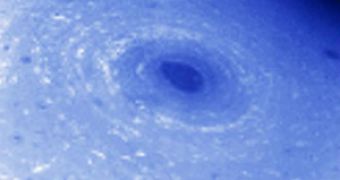Back here on Earth, we may experience some dangerous storms from time to time; however, they are nothing compared to the storms taking place on gas giants such as Saturn or Jupiter. These storms apparently never stop and are so big that the whole Earth would fit inside of them. Saturn's storm, for example, has a cyclone-like eye about 4,200 kilometers in diameter, with walls towering up to 70 kilometers above the surrounding cloud top.
"We're inclined to say that it's like a hurricane," said planetary scientists from California Institute of Technology, Ulyana Dyudina. However, while Jupiter's Great Red Spot is known to rage across the atmosphere of the planet for more than four centuries, the storm of Saturn has only been discovered in 2003. Gas giants usually host a couple hundred storms at a time, albeit none of them resemble even slightly the cyclone storms routinely taking place on Earth.
"The similarities are remarkable, especially that shadow cast by the eye wall - just like in a Category 5 hurricane on Earth," reveals Timothy Dowling of the Comparative Planetology Laboratory at the University of Louisville. Dowling, who did not participate in the study made at California Institute of Technology, says that the storm roaming around Saturn's south pole also has clockwise spin direction and can exceed wind speeds of 550 kilometers per hour.
The interesting thing about Saturn's storm is that it seems to be stationary, always moving around the south pole, while the storms on Earth are always on the move. "On Earth, hurricanes usually drift toward the pole and then crash into land," said Dyudina. This is because most of the energy that power them comes from the heat evaporation on large water surfaces such as the ocean, thus when they reach the land, they lose most of their energy and fade away.
However, gas giants have no surface, meaning there is nothing that can interfere with the storm's power source. Currently it is unknown for how long the storm has been active, it could even occur according to seasons, albeit because a Saturnian year is 30 times longer than an Earth year and the storm has been discovered only five years ago, the theory cannot be confirmed at this time.
Nonetheless, Dowling doesn't want to waste any time waiting for planetary scientists to determine the age of the storm or whether it is seasonal, especially given the unique opportunity to study the ammonia clouds forming the eye of the storm.
"The fact that we can see down into the well of this eye is itself a revelation. Because Saturn has no land - no place to land - no atmospheric chemist or dynamicist has ever seen before how the abyssal cloud decks look and act," Dowling adds.
Additionally, Saturn's south polar storm may provide scientists with some valuable insight into how the planet cooled over time, how the heat from its inner core escaped to the top layers and into space. On our planet for example, powerful storms take heat from the lower atmosphere and transfer it to the top layers. "If we see similar things on Saturn and the vortex is a mechanism for how the heat gets through the clouds to space, that would raise interesting questions about the mechanisms of cooling of this plane," says Dyudina.

 14 DAY TRIAL //
14 DAY TRIAL //